

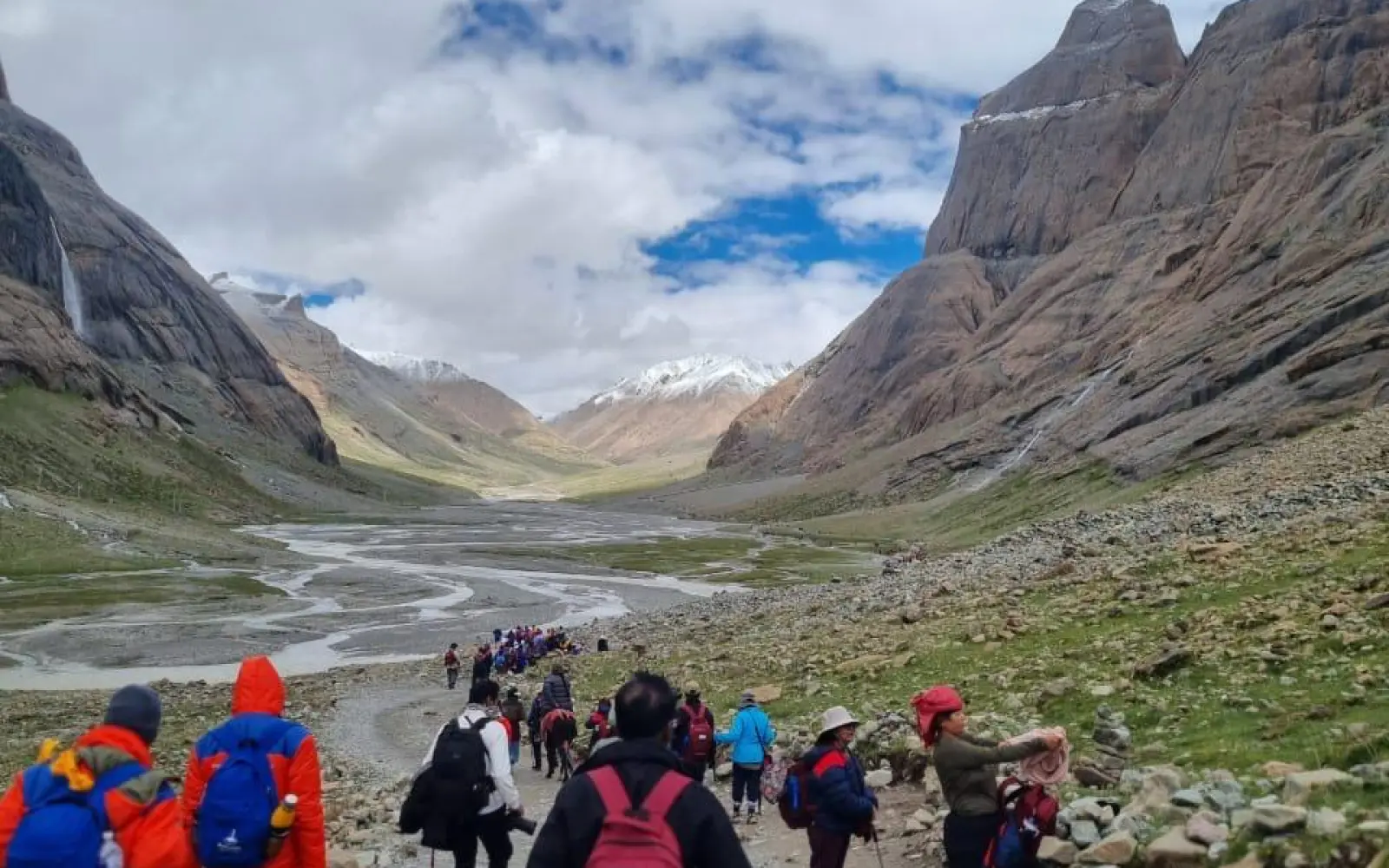
The ideal time to explore on Mt. Kailash Mansarovar Yatra is between May and September, with June to August being considered the peak pilgrimage season. During these months, the weather conditions are relatively stable, the high-altitude trails are more accessible, and the region is free from heavy snowfall. Daytime temperatures are moderate and conducive for trekking, usually ranging between 8°C to 18°C, while the nights remain cold, often dipping below freezing, especially in higher altitudes.
This period also coincides with several important Hindu and Buddhist festivals, such as Saga Dawa, which celebrates the birth, enlightenment, and death of Lord Buddha. For many pilgrims, attending the Yatra during these sacred events enhances the spiritual experience. The skies are generally clearer during the early monsoon, offering breathtaking views of the snow-capped peaks, crystal-clear lakes, and rugged Himalayan terrain. While the terrain remains challenging due to its altitude and remoteness, this window presents the safest and most comfortable time for the Yatra.
Mt. Kailash
Mt. Kailash, rising to an elevation of 6,638 meters (21,778 feet), is one of the most revered and mysterious peaks in the world. Located in the remote Tibetan Autonomous Region of China, this perfectly symmetrical, snow-capped mountain stands isolated from other peaks of the Himalayas, making it visually and spiritually distinct. Despite being a relatively modest peak in terms of altitude, Mt. Kailash holds unmatched religious and symbolic significance across multiple cultures and religions, and is often referred to as the axis mundi or the center of the spiritual universe.
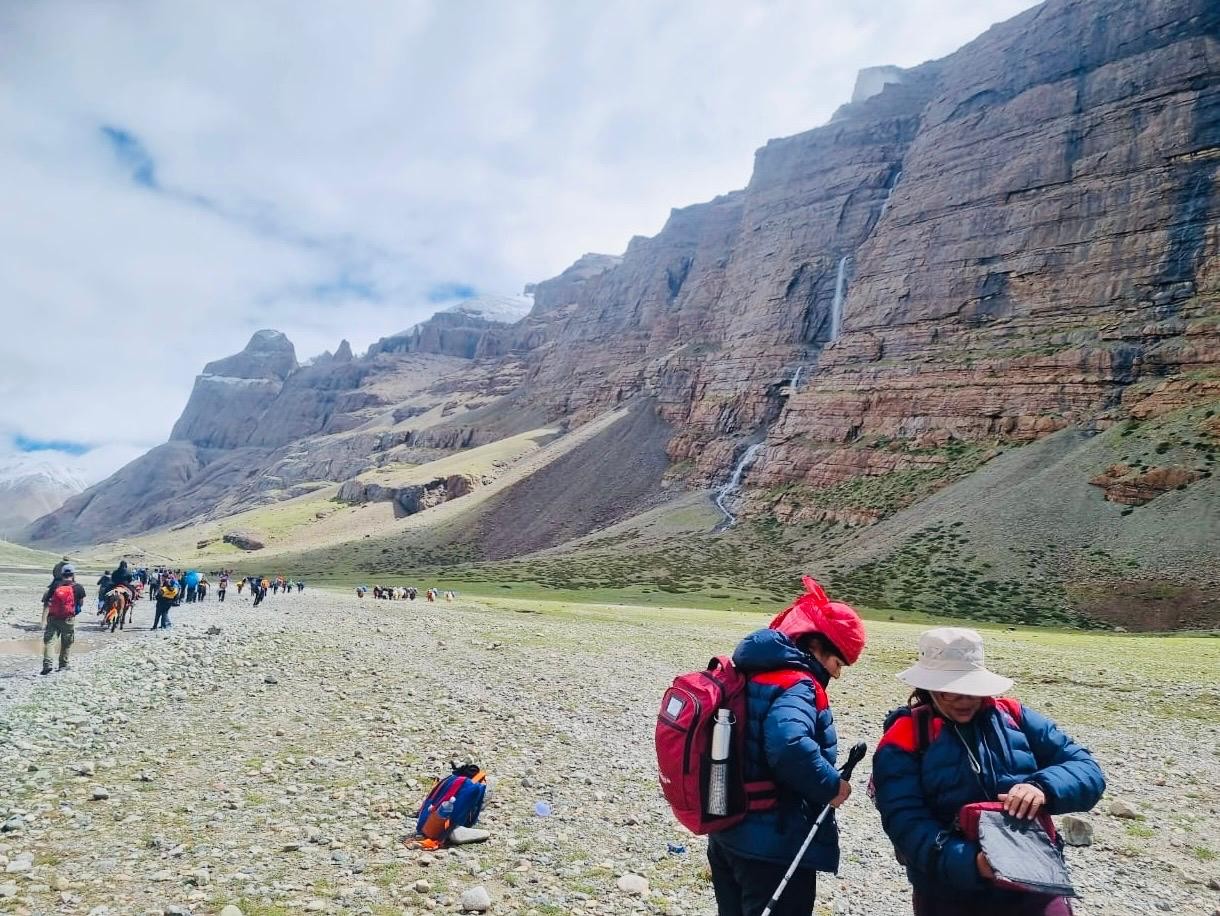 For Hindus, Mt. Kailash is considered the abode of Lord Shiva, the destroyer and transformer among the Holy Trinity. It is believed that Lord Shiva resides here in eternal meditation, along with his consort, Goddess Parvati. Buddhists identify the mountain as Kang Rinpoche, or the "Precious Snow Jewel," and see it as the seat of Demchok (Chakrasamvara), a wrathful deity representing supreme bliss. For Jains, Mt. Kailash is the site where their first Tirthankara, Rishabhadeva, attained liberation (moksha). The Bon religion, which predates Buddhism in Tibet, also considers it their spiritual center, believing their founder, Tonpa Shenrab, descended from heaven onto the mountain.
For Hindus, Mt. Kailash is considered the abode of Lord Shiva, the destroyer and transformer among the Holy Trinity. It is believed that Lord Shiva resides here in eternal meditation, along with his consort, Goddess Parvati. Buddhists identify the mountain as Kang Rinpoche, or the "Precious Snow Jewel," and see it as the seat of Demchok (Chakrasamvara), a wrathful deity representing supreme bliss. For Jains, Mt. Kailash is the site where their first Tirthankara, Rishabhadeva, attained liberation (moksha). The Bon religion, which predates Buddhism in Tibet, also considers it their spiritual center, believing their founder, Tonpa Shenrab, descended from heaven onto the mountain.
Unlike other famous peaks, climbing Mt. Kailash is strictly prohibited, out of deep respect for its sacred status. Instead, pilgrims undertake the Kora a 52-kilometer trek that circles the base of the mountain. This act of circumambulation, often done in silence or deep meditation, is believed to cleanse the soul, wash away lifetimes of sin, and bring one closer to enlightenment or spiritual liberation. The trek is physically demanding, taking pilgrims across high-altitude passes like Drolma La (5,630 meters), but the spiritual rewards far outweigh the hardships. For those who make the journey, Mt. Kailash is not just a destination it is a life-changing experience.
Lake Mansarovar
Nestled at an elevation of about 4,590 meters (15,060 feet) above sea level, Lake Mansarovar is one of the highest freshwater lakes in the world and one of the holiest in Asia. Located near the base of Mt. Kailash in the remote region of western Tibet, this serene lake is an integral part of the Kailash Mansarovar Yatra and holds deep spiritual significance for followers of Hinduism, Buddhism, Jainism, and Bon. Its name is derived from the Sanskrit words Manas (mind) and Sarovar (lake), signifying a lake born from the mind of Lord Brahma, the creator of the universe.
According to Hindu mythology, it is believed that a ritual bath in the pure, icy waters of Lake Mansarovar cleanses all sins and grants spiritual liberation (moksha). Devotees often take a holy dip and perform pujas (prayers) on its shores, especially during auspicious months like Saga Dawa or during a full moon, when the lake is said to emit a powerful spiritual energy. In Buddhist tradition, the lake is revered as a representation of spiritual purity and is associated with Queen Maya, the mother of Buddha, who is believed to have bathed in it before giving birth. The Bonpo tradition sees the lake as a symbol of the sky goddess, and for Jains, it complements the sanctity of nearby Mt. Kailash, the place of liberation for their first Tirthankara.
Geographically, Mansarovar is remarkable not only for its religious prominence but also for its natural beauty. The lake spans approximately 88 kilometers in circumference, with crystal-clear waters that reflect the majestic snow-capped peaks surrounding it. On a clear day, you can see the perfect mirror image of Mt. Kailash on its surface, making it a deeply awe-inspiring sight. Close by is Rakshas Tal, or the Lake of Demons, representing dark energies in contrast to the spiritual purity of Mansarovar. Pilgrims and trekkers visiting this sacred region often spend a night near the lake, absorbing the calm, meditative atmosphere that has remained untouched for centuries.
Significance of the Yatra – Spiritual, Cultural, and Geographical Importance
The Mt. Kailash Mansarovar Yatra holds immense spiritual significance for multiple religious traditions, including Hinduism, Buddhism, Jainism, and Bon. In Hinduism, Mt. Kailash is revered as the dwelling place of Lord Shiva and Goddess Parvati, and completing the parikrama (circumambulation) of the mountain is believed to bring moksha (liberation from the cycle of birth and death). For Buddhists, Mt. Kailash is associated with Demchok (Chakrasamvara), a deity symbolizing supreme bliss. The mountain is also seen as the center of the universe in Buddhist cosmology.
Culturally, the Yatra attracts thousands of devotees and adventurers from India, Nepal, and around the world each year. Despite its remote location and physically demanding terrain, the journey unites people from different backgrounds, cultures, and spiritual paths. The ritual of circumambulating Mt. Kailash a 52 km trek around the base of the mountain takes 2 to 3 days and is a powerful expression of devotion, humility, and endurance. Many pilgrims perform this kora in silence or even prostrate themselves the entire distance, adding to the Yatra’s mystical allure.
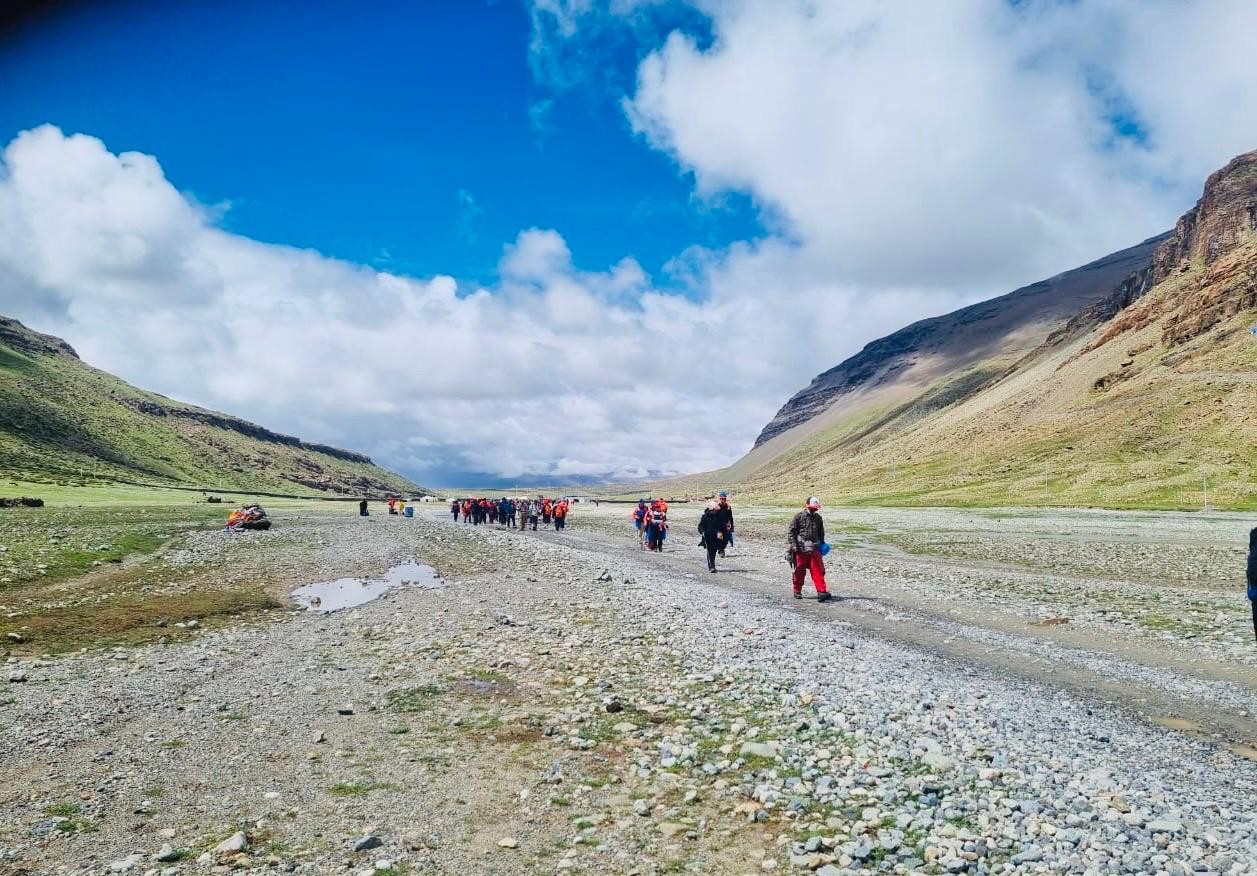 Geographically, the region surrounding Mt. Kailash and Lake Mansarovar are not only spiritually significant but also ecologically unique. The Yatra route traverses through vast Tibetan plateaus, glacial valleys, and remote Himalayan passes like the Drolma La Pass (5,630 meters), offering an unmatched blend of natural beauty and spiritual intensity. The desolate yet awe-inspiring landscape enhances the pilgrim’s inner journey, symbolizing the crossing from the mundane to the divine.
Geographically, the region surrounding Mt. Kailash and Lake Mansarovar are not only spiritually significant but also ecologically unique. The Yatra route traverses through vast Tibetan plateaus, glacial valleys, and remote Himalayan passes like the Drolma La Pass (5,630 meters), offering an unmatched blend of natural beauty and spiritual intensity. The desolate yet awe-inspiring landscape enhances the pilgrim’s inner journey, symbolizing the crossing from the mundane to the divine.
Altitude and Terrain Overview
The Mt. Kailash region, located in the Ngari Prefecture of western Tibet, is part of the Trans-Himalayan range and sits in one of the most remote and geologically striking landscapes on Earth. Mt. Kailash itself stands tall at 6,638 meters (21,778 feet), but the terrain surrounding it includes wide plateaus, glacial valleys, high-altitude deserts, and dramatic mountain passes. Pilgrims and trekkers undertake the Kora or circumambulation of Mt. Kailash, which spans approximately 52 kilometers and includes a crossing over the Drolma La Pass (5,630 meters/18,470 feet) the highest point of the trek.
The region’s elevation varies dramatically, with base camp areas and Lake Mansarovar sitting around 4,590 meters (15,060 feet). This extreme altitude can pose risks such as Acute Mountain Sickness (AMS), so proper acclimatization and physical preparation are crucial. Despite the rugged and barren look of the landscape, it is filled with striking natural beauty jagged peaks, deep river gorges, pristine lakes, and open skies that seem to stretch endlessly. The terrain is mostly rocky and uneven, with occasional snowfields even in summer, making it both a physically challenging and spiritually rewarding destination.
Seasonal Weather Patterns in Tibet and Surrounding Areas
The climate of Mt. Kailash region is classified as high-altitude arid and alpine, with long, harsh winters and short, cool summers. The best time to visit is during the late spring to early autumn months (May to September). During this period, daytime temperatures are more moderate, ranging between 8°C to 18°C (46°F to 64°F), although nighttime temperatures can still fall below freezing. These months also bring clearer skies, which provide spectacular views of Mt. Kailash and allow for safer trekking conditions.
Winter (from October to April) is extremely cold, with heavy snowfall and sub-zero temperatures that make travel nearly impossible and often result in the closure of access routes due to snow-covered passes. The monsoon season (July and August) brings sporadic rainfall, but because the region lies in the rain shadow of the Himalayas, it receives significantly less precipitation than central or southern Tibet. However, weather in the mountains can change rapidly even in summer so trekkers must be prepared for sudden drops in temperature, snowfall at high altitudes, and strong winds.
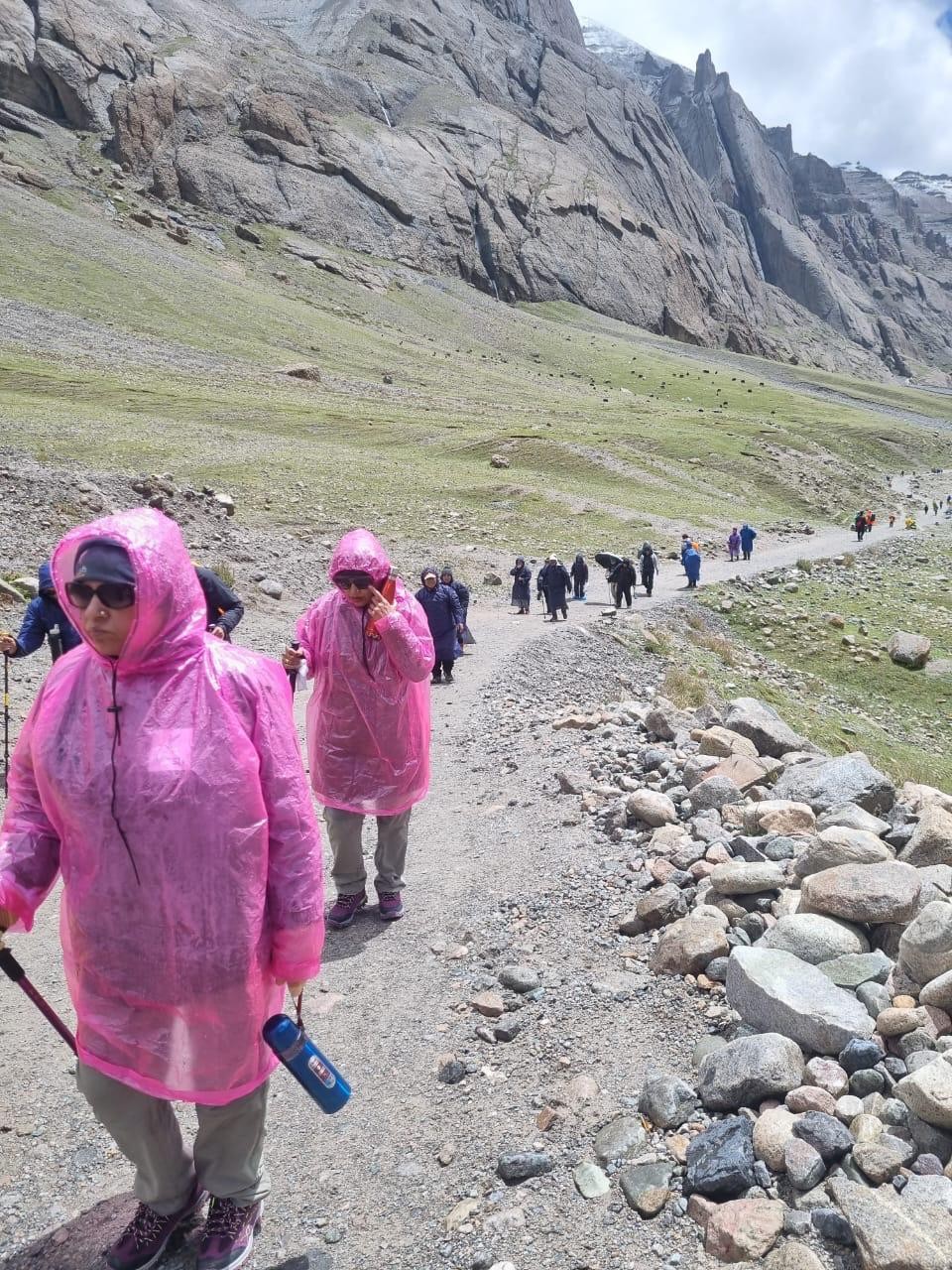 For those undertaking the pilgrimage with Bharal Adventure Trek, expert guidance, proper gear, and gradual acclimatization are vital to navigating the challenging climate and terrain safely. Whether you are drawn by the adventure, the sacred energy, or the surreal beauty, understanding the geography and weather of the Mt. Kailash region is key to a successful and transformative journey.
For those undertaking the pilgrimage with Bharal Adventure Trek, expert guidance, proper gear, and gradual acclimatization are vital to navigating the challenging climate and terrain safely. Whether you are drawn by the adventure, the sacred energy, or the surreal beauty, understanding the geography and weather of the Mt. Kailash region is key to a successful and transformative journey.
Spring (April to Mid-June)
Advantages: Mild Weather, Less Crowded
Spring marks the beginning of the pilgrimage season for Mt. Kailash and Lake Mansarovar. From April to mid-June, the region slowly emerges from the grip of winter, and the snow begins to melt, opening up the remote routes to the Tibetan plateau. This is one of the best times to undertake the Kailash Mansarovar Yatra due to the relatively mild temperatures and the gradual return of accessibility to key pilgrimage routes. Daytime temperatures can range between 5°C and 15°C, making the weather pleasant for trekking and spiritual exploration.
Another major advantage of visiting in spring is the smaller number of pilgrims and tourists compared to the peak summer season. This gives travelers a more peaceful and personal experience during the Kora (circumambulation) and at Lake Mansarovar. The fewer crowds mean less congestion at checkpoints, fewer delays, and a more serene atmosphere for meditation and spiritual rituals. It’s an ideal time for those who value solitude and prefer a more contemplative journey.
Considerations: Melting Snow, Early Accessibility
Despite its advantages, spring travel to Mt. Kailash comes with some logistical and environmental challenges. The melting snow can cause muddy trails, swollen rivers, and slippery conditions along the route, particularly on the higher elevations like Drolma La Pass. Some trails and roads might still be partially blocked or only recently opened, especially during early April. Trekking infrastructure may also be limited in the very early part of the season, as local businesses and accommodations gradually reopen.
Travelers should also be prepared for cold nights and unpredictable weather patterns, including sudden snowfall or high winds. Proper cold-weather gear and a slower pace for acclimatization are essential during this time. That said, with experienced guides like those from Bharal Adventure Trek, spring remains one of the most rewarding times to visit offering a perfect blend of natural beauty, spiritual depth, and peaceful solitude.
Summer (Mid-June to August)
Advantages: Peak Pilgrimage Season, Full Accessibility
Summer is the busiest and most vibrant season for Mt. Kailash Mansarovar Yatra. From mid-June to August, weather conditions are at their most stable, and the region is fully accessible for trekking and pilgrimage activities. Temperatures during the day range between 10°C to 20°C, making it the most comfortable period for high-altitude travel. Most of the snow has melted by this time, and mountain passes like Drolma La are usually clear and open, allowing for safer and more predictable routes.
This period coincides with several important religious festivals, such as Saga Dawa, a major Tibetan Buddhist celebration commemorating the birth, enlightenment, and death of Lord Buddha. The energy around Mt. Kailash and Lake Mansarovar reaches its spiritual peak, with thousands of devotees from all over the world gathering to perform the sacred Kora. The festive atmosphere, combined with clear skies and full accessibility, makes this the most spiritually and logistically optimal time for many travelers. Bharal Adventure Trek often schedules multiple departures during this window to accommodate higher demand.
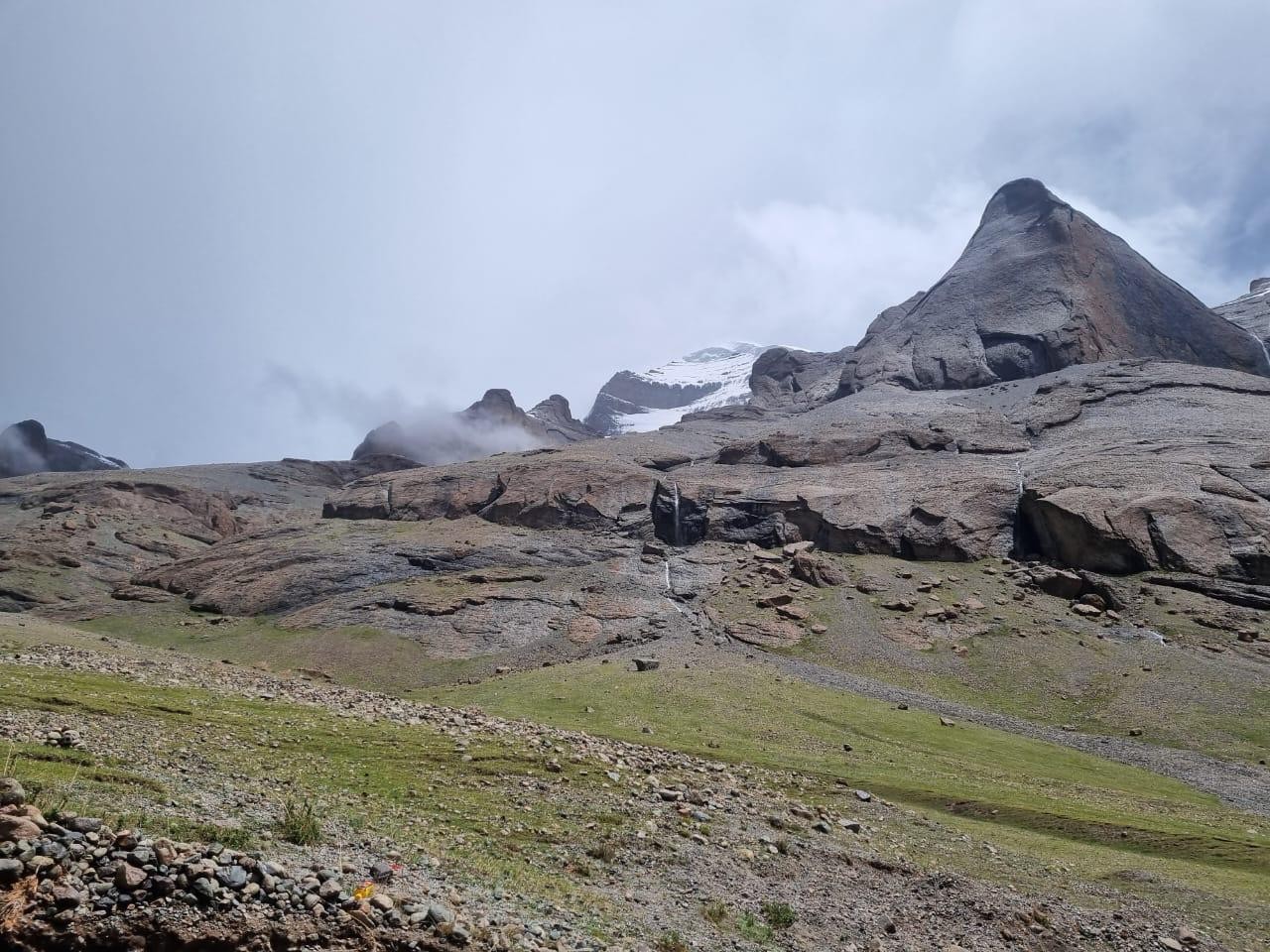 Considerations: Monsoon Influence in Surrounding Regions
Considerations: Monsoon Influence in Surrounding Regions
While the Tibetan plateau itself experiences limited rainfall due to its location in the rain shadow of the Himalayas, the approach routes especially those from Nepal and India can be affected by the South Asian monsoon. Regions like Simikot, Hilsa, and the Nepalgunj–Kathmandu corridor may experience flight delays, muddy trails, and landslides, potentially causing disruptions in travel plans. It is crucial to factor in buffer days for delays when planning your itinerary.
In the high-altitude Kailash region, sudden weather changes, including brief showers or high winds, are still possible and can affect visibility and trekking conditions. Pilgrims are advised to carry proper rain gear and be prepared for variable weather. Despite these considerations, summer remains the most popular and rewarding season for the Yatra, offering the best chance for a successful and spiritually fulfilling journey.
Autumn (September to Mid-October)
Advantages: Clear Skies, Fewer Tourists
Autumn is a tranquil and scenic time to undertake the Mt. Kailash Mansarovar Yatra. From September to mid-October, the region enjoys crisp air, minimal precipitation, and crystal-clear skies, making it ideal for photography and appreciating the vast Himalayan and Tibetan landscapes. The monsoon has receded, leaving behind clean, dust-free trails and vibrant mountain views. For pilgrims and trekkers who prefer solitude and natural beauty over crowds, this is an exceptionally rewarding season.
With the peak summer crowds having dissipated, the trails are quieter, and accommodations are easier to find. This creates a more intimate and reflective atmosphere around Mt. Kailash and Lake Mansarovar. The reduced foot traffic allows for a more peaceful circumambulation, ideal for deep spiritual connection, meditation, and meaningful personal moments. The season is especially suitable for those seeking a calmer, more contemplative pilgrimage experience, and Bharal Adventure Trek often recommends this time for travelers wanting to avoid the hectic summer flow.
Considerations: Colder Nights, Shorter Days
Despite its many advantages, autumn brings cooler temperatures, especially at night. While daytime weather remains pleasant (between 5°C to 14°C), nighttime temperatures can drop below -5°C at higher altitudes. Layered clothing, insulated sleeping gear, and proper thermal protection are essential for comfort and safety. As sunlight hours shorten, it’s also important to plan trekking segments carefully to ensure that longer stretches are completed during daylight.
In addition, by mid-October, many local services, especially those operated seasonally, begin winding down in preparation for the coming winter. Sudden cold snaps and early snowfall, though uncommon, can occur at high altitudes, including the Drolma La Pass, potentially affecting travel schedules. However, with appropriate planning and the support of experienced guides from Bharal Adventure Trek, autumn offers one of the most serene and visually stunning windows for a successful Yatra.
Winter (Mid-October to March)
Challenges: Extreme Cold, Closed Routes
Winter in the Mt. Kailash region, stretching from mid-October to March, brings some of the harshest conditions in the Himalayas. Temperatures during this period plummet well below freezing, often dropping to -20°C (-4°F) or lower, especially at night and in high-altitude areas like Drolma La Pass. The already remote terrain becomes increasingly isolated as snow accumulates, blocking roads, mountain passes, and essential trekking routes. Accessibility to key pilgrimage sites such as Lake Mansarovar and the Kailash Kora trail is either severely limited or completely cut off due to heavy snowfall and icy conditions.
In addition to the bitter cold, strong winds, frequent blizzards, and minimal daylight hours make outdoor travel extremely difficult and risky. Even support vehicles, horses, and porters often cannot operate in such conditions. Local facilities such as teahouses, lodges, and supply points are usually closed for the season, leaving travelers with very few resources. For these reasons, tour operators like Bharal Adventure Trek do not recommend or schedule group departures during the winter months.
Why It’s Generally Avoided
The winter season is widely avoided by pilgrims and trekkers for both practical and safety reasons. Apart from the obvious logistical barriers, the harsh weather greatly increases the risk of altitude sickness, frostbite, hypothermia, and isolation in case of emergencies. Even experienced high-altitude travelers find the conditions too extreme for a successful pilgrimage or trek.
For those considering the Yatra during this period, it’s important to understand that spiritual fulfillment should not come at the cost of personal safety. Most travelers wait until spring or summer when the paths reopen, the weather stabilizes, and local infrastructure can support a safe and meaningful journey. If spiritual solitude is a key goal, late spring or early autumn offer far better conditions without the hazards of winter. At Bharal Adventure Trek, your safety and well-being are our top priorities, and we recommend planning your journey during the optimal pilgrimage windows.
Weather and Trail Conditions
The Mt. Kailash Parikrama, or circumambulation, is a deeply spiritual and physically demanding trek that covers approximately 52 kilometers around the sacred mountain. Choosing the ideal time to undertake this journey is crucial to ensure both safety and a fulfilling experience. The best window for the Parikrama typically falls between late May and early September, coinciding with the broader pilgrimage season when the weather is comparatively mild and stable.
During this period, daytime temperatures range from 8°C to 18°C, providing comfortable conditions for walking. The trails are largely free of snow, especially after late May, and mountain passes like the challenging Drolma La Pass (5,630 meters) are usually accessible. Clear skies prevail most days, offering spectacular views of Mt. Kailash’s pristine, snow-capped peaks and surrounding landscapes. However, trekkers should remain prepared for sudden weather changes, including brief rain showers or chilly winds, particularly in the afternoons and evenings.
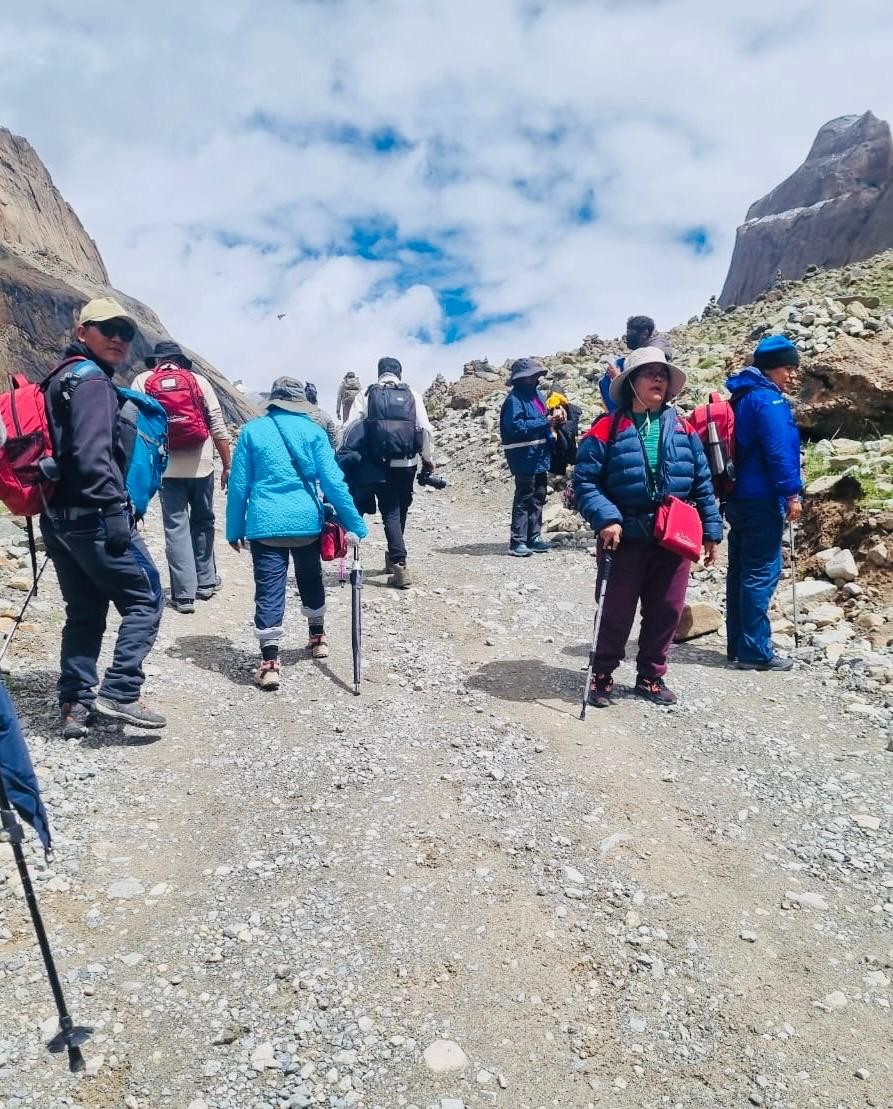 In contrast, undertaking the Parikrama outside this window especially during winter or early spring can mean deep snow, icy paths, and extreme cold, making the trek dangerous or impossible. Therefore, timing the circumambulation to coincide with the warmest months maximizes safety and spiritual fulfillment.
In contrast, undertaking the Parikrama outside this window especially during winter or early spring can mean deep snow, icy paths, and extreme cold, making the trek dangerous or impossible. Therefore, timing the circumambulation to coincide with the warmest months maximizes safety and spiritual fulfillment.
Acclimatization and Safety Factors
Given the high-altitude nature of the Parikrama, proper acclimatization is essential for a safe and enjoyable trek. The route climbs as high as 5,630 meters at the Drolma La Pass, placing trekkers at significant risk of Acute Mountain Sickness (AMS) if they ascend too quickly or without adequate preparation. Bharal Adventure Trek emphasizes a gradual ascent, allowing pilgrims to spend sufficient time at intermediate altitudes such as Lake Mansarovar (4,590 meters) and base camps to adapt physically.
Safety protocols also include hydration, balanced nutrition, and avoidance of strenuous exertion in the first days of the trek. Experienced guides monitor each pilgrim for symptoms of altitude sickness and adjust pacing accordingly. Rest days are often incorporated into the itinerary to ensure everyone remains in good health throughout the journey.
Furthermore, the remote and rugged terrain demands preparedness for sudden weather changes, possible landslides, and limited emergency access. Bharal Adventure Trek provides comprehensive logistical support, including well-coordinated porters, medical kits, and contingency plans. Wearing appropriate layered clothing, carrying sun protection, and using trekking poles are also recommended for enhanced safety and comfort.
By choosing the ideal time for the Parikrama and following expert acclimatization and safety guidelines, pilgrims can focus on the profound spiritual meaning of their journey while confidently navigating the physical challenges of the sacred Mt. Kailash circulation.
Saga Dawa Festival (Usually in May or June)
One of the most revered and spiritually potent festivals celebrated during the Mt. Kailash Mansarovar Yatra is the Saga Dawa Festival, which typically falls in May or June, depending on the Tibetan lunar calendar. Saga Dawa commemorates three pivotal events in the life of Lord Buddha: his birth, enlightenment (Buddhahood), and parinirvana (passing away). This month is regarded as the most sacred time in Tibetan Buddhism, making the pilgrimage to Mt. Kailash and Lake Mansarovar are even more meaningful.
During Saga Dawa, thousands of Buddhist pilgrims from Tibet, Nepal, India, and beyond flock to Mt. Kailash to perform the Kora (circumambulation) and other spiritual rituals. The air is filled with prayers, the ringing of prayer wheels, and the chanting of sacred mantras, creating an atmosphere charged with deep devotion and positive energy. It is believed that merits earned during this month multiply exponentially, and acts such as bathing in Lake Mansarovar or completing the Kailash Parikrama bring immense spiritual purification and blessings. For many pilgrims, participating in the Yatra during Saga Dawa is a once-in-a-lifetime opportunity to connect profoundly with their faith.
Importance of Aligning the Yatra with Religious Events
Timing the Kailash Mansarovar Yatra to coincide with major religious festivals like Saga Dawa significantly enhances the spiritual value of the journey. Such alignment offers pilgrims a unique opportunity to experience the rich cultural traditions, vibrant rituals, and communal devotion that define the sacred landscape. Festivals infuse the pilgrimage with a palpable sense of shared faith and celebration, elevating the personal experience into a collective spiritual awakening.
Moreover, religious events often bring together experienced monks, ritual specialists, and local communities who perform ceremonies that pilgrims can witness or participate in, deepening their understanding and connection to the region’s heritage. While these periods may attract larger crowds, Bharal Adventure Trek ensures thoughtful planning and smooth logistics so travelers can engage fully with the festivities without compromising comfort or safety.
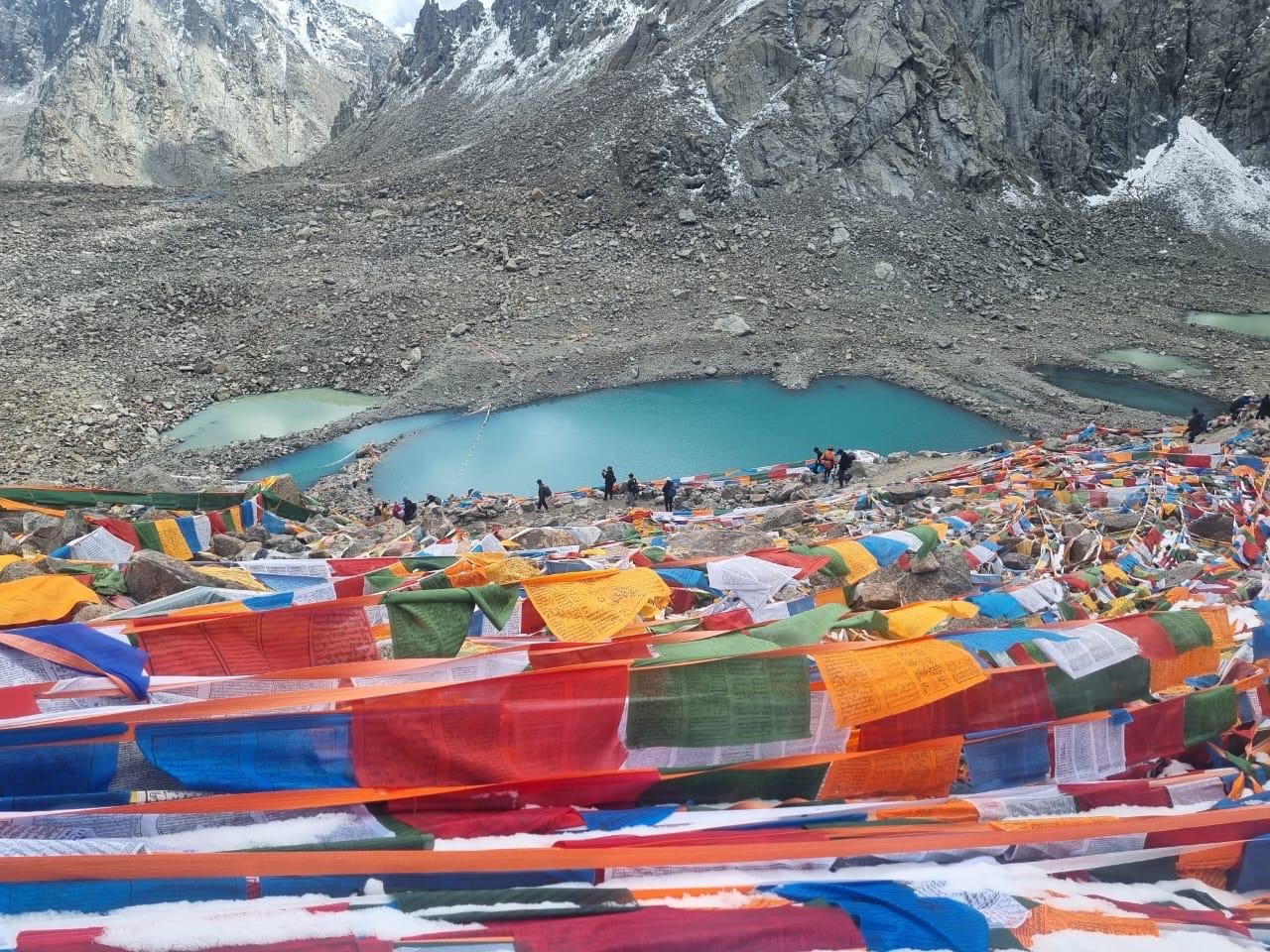 For those seeking a more solitary or contemplative experience, other months like late spring or early autumn provide peaceful alternatives with fewer pilgrims but still favorable weather. Ultimately, whether aligned with a festival or during a quieter time, the Mt. Kailash Mansarovar Yatra remains a profound spiritual journey, with Bharal Adventure Trek guiding pilgrims every step of the way.
For those seeking a more solitary or contemplative experience, other months like late spring or early autumn provide peaceful alternatives with fewer pilgrims but still favorable weather. Ultimately, whether aligned with a festival or during a quieter time, the Mt. Kailash Mansarovar Yatra remains a profound spiritual journey, with Bharal Adventure Trek guiding pilgrims every step of the way.
Route Availability (Nepal, China-Tibet, Indian Government-Organized Routes)
The Mt. Kailash Mansarovar Yatra can be accessed primarily via three main routes, each with its own seasonal considerations and logistical requirements:
Permit Timing and Group Travel Constraints
Travel to the Mt. Kailash region requires several permits issued by Chinese and Indian authorities, with specific timelines and restrictions depending on the route and season:
By understanding these seasonal travel logistics and permit requirements, pilgrims can plan their Mt. Kailash Mansarovar Yatra with confidence and ease. Bharal Adventure Trek specializes in managing these complexities, providing a hassle-free and well-organized pilgrimage experience that respects all legal and cultural protocols.
Kathmandu
The journey begins in Kathmandu, Nepal’s vibrant capital city. Known for its rich history, ancient temples, and bustling markets, Kathmandu serves as the cultural gateway to Tibet. Pilgrims spend a day or two here to prepare permits, gather supplies, and acclimatize. The city’s unique blend of Hindu and Buddhist heritage offers a glimpse into the spiritual traditions that underscore the Kailash Mansarovar Yatra.
Simikot
From Kathmandu, travelers take a domestic flight to Simikot, a remote mountain town in Nepal’s Humla district. Simikot acts as the starting point for the trek toward the Nepal-Tibet border. The town is small but strategically important, nestled amid the Himalayas, and serves as the last hub of civilization before the rugged trek ahead. Preparations and briefing often occur here before exploring on the high-altitude journey.
Trek to Hilsa
Pilgrims then undertake a multi-day trek from Simikot to Hilsa, the border town connecting Nepal and Tibet. This trek is an adventurous and scenic passage through the Himalayan foothills, crossing rivers, forests, and remote villages inhabited by indigenous communities. Along the way, travelers begin to experience the dramatic change in landscape and culture as they approach the Tibetan plateau.
Hilsa (Nepal-Tibet Border)
Hilsa is a small, bustling border town where pilgrims complete customs formalities and cross into Tibet. The transition here marks the beginning of the Tibetan leg of the pilgrimage. Hilsa’s vibrant trade market and Tibetan influences introduce travelers to the distinct culture and traditions of the region.
Taklakot (Purang)
Upon entering Tibet, the first major step is Taklakot (also known as Purang), an ancient trading town near the Indian border. Taklakot is a key acclimatization point and a cultural hub where pilgrims can rest, prepare for the next stages, and visit local monasteries. The town provides essential services and a welcome respite after the border crossing.
Kyirung (Gyirong)
Kyirung, also known as Gyirong, is the Tibet border town where pilgrims officially enter from Nepal. It serves as the gateway to the sacred region of Mt. Kailash. Nestled at an altitude of around 2,700 meters, Kyirung offers an important acclimatization stop with basic facilities. The town is rich with Tibetan culture, monasteries, and vibrant local markets, providing a glimpse of Tibetan life as pilgrims begin their journey deeper into the plateau.
Saga
Saga is a small Tibetan township located approximately halfway between Kyirung and Mansarovar Lake. Situated on the banks of the Brahmaputra River, Saga is an important rest point for pilgrims. It provides necessary services such as food, lodging, and medical aid, and serves as a key acclimatization spot before proceeding to higher altitudes. The area around Saga is known for its rugged landscapes and views of the Himalayan ranges.
Darchen
Darchen is the main base camp for pilgrims undertaking the Kailash Parikrama (circumambulation). Located at about 4,670 meters altitude, this small settlement is the last inhabited area before the sacred mountain and lake. It serves as the starting and ending point for the 52-kilometer trek around Mt. Kailash. Pilgrims often spend a day here preparing mentally and physically for the challenging circumambulation ahead.
Paryang (Gyanak)
Paryang, also known as Gyanak, is a historic Tibetan town along the pilgrimage route. It is renowned for its Buddhist monasteries and serene landscapes. Pilgrims often stop here during their journey, experiencing local culture and spirituality. Paryang serves as a peaceful resting spot before heading towards Mansarovar Lake and the mountain.
Dira Puk (Dirapuk)
Dira Puk, or Dirapuk, is one of the primary high-altitude camps along the Kailash Parikrama trail. Located just before the Drolma La Pass (the highest point of the circumambulation), it provides crucial rest and acclimatization for pilgrims preparing to cross the pass at 5,630 meters. The campsite offers incredible views of the north face of Mt. Kailash and the surrounding valleys.
Zuthul Puk (Zuthulpuk)
Zuthul Puk, meaning “Good Fortune Cave,” is a sacred cave near the town of Darchen. According to Tibetan Buddhist belief, Guru Rinpoche (Padmasambhava) meditated here, subduing evil spirits. Pilgrims visit the cave to offer prayers and seek blessings, making it a spiritually significant stop on the pilgrimage route.
Lake Mansarovar
One of the most sacred sites on the Yatra, Lake Mansarovar lies at an altitude of approximately 4,590 meters. This pristine freshwater lake is revered in Hinduism, Buddhism, Jainism, and Bon traditions. Pilgrims bathe in its holy waters, believing it purifies the soul and cleanses sins. The serene beauty of the lake against the backdrop of the Himalayan peaks makes it a highlight of the journey.
Mt. Kailash
The ultimate destination and the spiritual heart of the Yatra, Mt. Kailash is a majestic peak rising 6,638 meters above sea level. Revered as the abode of Lord Shiva in Hinduism and the axis mundi in several other religions, the mountain is a focal point of devotion. Pilgrims undertake the Kailash Parikrama (circumambulation), a challenging 52-kilometer trek around the mountain, considered a profound spiritual practice that brings blessings and enlightenment.
Planning a successful Mt. Kailash Mansarovar Yatra depends greatly on choosing the right time to explore on this sacred journey. Based on weather conditions, accessibility, spiritual significance, and personal preferences, the best months to visit are generally between late April and early October. This period offers the most favorable climate, open trails, and functional border crossings, with each season providing unique advantages.
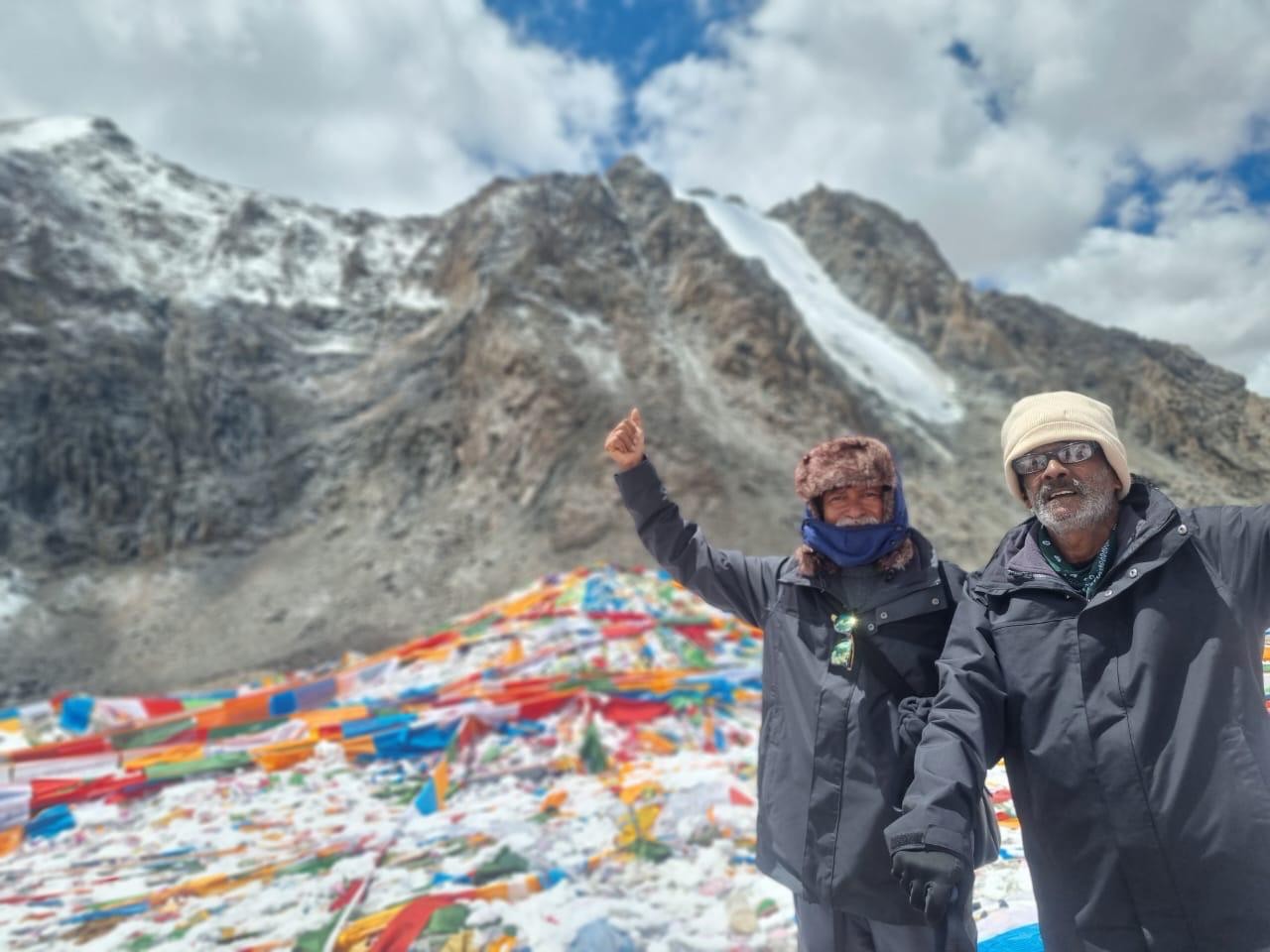 Spring (April to mid-June) is ideal for travelers seeking mild weather and a quieter pilgrimage experience with fewer crowds. It’s a perfect time for spiritual seekers who want to connect deeply with the natural and sacred surroundings in relative solitude. Summer (mid-June to August), the peak pilgrimage season, combines optimal accessibility with vibrant religious festivals such as Saga Dawa, offering an enriching cultural and spiritual immersion. Autumn (September to mid-October) is best for those who prefer clear skies, stunning scenic views, and a more peaceful atmosphere as the summer crowds begin to thin.
Spring (April to mid-June) is ideal for travelers seeking mild weather and a quieter pilgrimage experience with fewer crowds. It’s a perfect time for spiritual seekers who want to connect deeply with the natural and sacred surroundings in relative solitude. Summer (mid-June to August), the peak pilgrimage season, combines optimal accessibility with vibrant religious festivals such as Saga Dawa, offering an enriching cultural and spiritual immersion. Autumn (September to mid-October) is best for those who prefer clear skies, stunning scenic views, and a more peaceful atmosphere as the summer crowds begin to thin.
On the other hand, winter months (mid-October to March) are generally avoided due to extreme cold, closed routes, and limited services, making the pilgrimage challenging and potentially unsafe.
When deciding the optimal time for your Yatra, consider your personal goals:
At Bharal Adventure Trek, we are committed to helping you select the best time that aligns with your aspirations and ensuring a safe, comfortable, and transformative pilgrimage. With expert planning, knowledgeable guides, and comprehensive support, your Mt. Kailash Mansarovar Yatra will be an unforgettable journey physically, spiritually, and culturally.
1. Thoughtfully Designed Itinerary
This Yatra tour is carefully crafted to balance spiritual fulfillment, physical endurance, and cultural immersion. Every stop from the holy Mansarovar Lake to the majestic Mt. Kailash circumambulation is planned to maximize your experience while allowing ample time for acclimatization and reflection.
2. Optimal Timing and Route
The tour follows the best seasonal windows to ensure safe travel and favorable weather conditions. By choosing this itinerary, you avoid the harsh winter months and monsoon disruptions, giving you the best chance for a smooth and rewarding pilgrimage.
3. Comprehensive Coverage of Sacred Sites
This tour includes all major spiritual and cultural highlights such as Kyirung, Saga, Darchen, Mansarovar Lake, Dira Puk, Zuthul Puk, and the full Kailash Parikrama, offering a complete and immersive pilgrimage experience.
4. Balanced Pace and Acclimatization
The itinerary is designed with a gradual ascent and rest days at critical points to help your body adjust to the high altitude, reducing the risk of altitude sickness and improving overall safety.
5. Rich Spiritual and Cultural Experiences
Beyond trekking, the tour integrates opportunities to witness local rituals, visit sacred monasteries, and participate in traditional ceremonies, deepening your connection to the spiritual heritage of the region.
6. Focus on Comfort and Support
While the journey is challenging, this tour ensures access to reliable accommodations, quality meals, and attentive support throughout, making your pilgrimage as comfortable and stress-free as possible.
Choosing this Mt. Kailash Mansarovar Yatra tour means embarking on a well-organized, spiritually enriching, and physically manageable pilgrimage crafted to make your sacred journey unforgettable.
1. Expert Knowledge and Local Experience
At Bharal Adventure Trek, we specialize in high-altitude spiritual pilgrimages, with years of hands-on experience organizing safe and seamless Mt. Kailash Mansarovar Yatras. Our expert guides are deeply familiar with the region’s geography, culture, and religious significance, ensuring that your journey is not only safe but profoundly meaningful. Our local connections in Tibet and Nepal help us navigate the complex permit processes and provide authentic cultural experiences beyond the usual tourist routes.
2. Comprehensive Permit and Logistical Support
The Mt. Kailash Mansarovar Yatra involves complicated permit requirements and border regulations that can be overwhelming for independent travelers. Bharal Adventure Trek takes the hassle out of the process by handling all the necessary paperwork, including Tibet Travel Permits, group approvals, and special permissions. Our strong relationships with local authorities ensure smooth border crossings and timely approvals, allowing you to focus entirely on your spiritual journey.
3. Tailored Itineraries for Every Pilgrim
We understand that every pilgrim’s needs and goals are unique. Whether you seek a spiritually immersive experience, a comfortable journey with luxury options, or a budget-friendly adventure, Bharal Adventure Trek customized itineraries to match your preferences. Our flexible schedules accommodate varying fitness levels, acclimatization needs, and interests, making the Yatra accessible and rewarding for all.
4. Safety and Health Prioritized
Your safety is our top priority. Our experienced guides are trained in high-altitude trekking and first aid, constantly monitoring the group’s health to prevent altitude sickness and other risks. We provide detailed pre-trip advice, acclimatization plans, and emergency support throughout the journey. With Bharal Adventure Trek, you can trek confidently knowing you are in capable and caring hands.
5. Authentic Cultural and Spiritual Engagement
Beyond logistics, we strive to enrich your pilgrimage with authentic cultural encounters. From visits to ancient monasteries and sacred caves to participation in local festivals and rituals, our tours offer deep engagement with Tibetan Buddhism and Himalayan traditions. We foster respectful interactions that honor the sanctity of this spiritual landscape.
6. Comprehensive Support and Transparent Pricing
From the moment you inquire to the final day of your pilgrimage, Bharal Adventure Trek provides clear communication, dedicated support, and transparent pricing with no hidden costs. We offer full-service packages including transport, accommodation, meals, permits, guides, and porters, ensuring a hassle-free and memorable journey.


Trekking in the Himalayas of Nepal is a journey that promises breathtaking landscapes, challenging trails, and a cultural experience like no other. Ne...

Nepal, a jewel in the Himalayas, beckons trekkers and adventure seekers from across the globe. Its majestic mountains, verdant valleys, and diverse...
